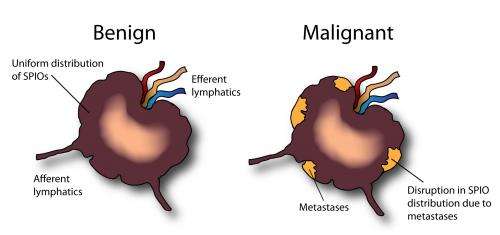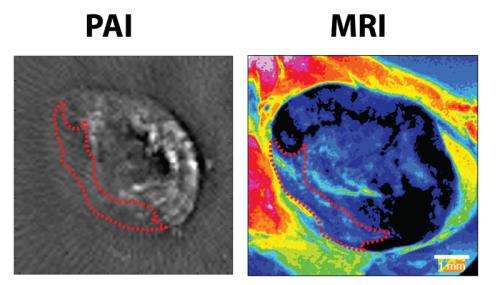Ironoxyde particles spread uniformly when there are no metastases, but show gaps (right, yellow) when there are.
If a tumour has spread through the lymph nodes, the decision is often taken to exercise caution and remove extra tissue, to prevent it from spreading further. This often involves the removal of healthy lymph nodes. Photoacoustic detection allows surgeons to see which nodes are affected and which are not, while the operation is in progress. This could cut the number of unnecessary complications following surgery, while still ensuring that all affected tissue is removed. Diederik Grootendorst of the University of Twente's MIRA research institute yesterday defended his PhD thesis based on research into this technique.
The examination of tissue samples currently involves extensive laboratory tests. As a result, surgeons have to wait several days for confirmation of the presence or absence of metastases in the excised lymph nodes. If it was possible to obtain this information during surgery, then further operations could be avoided. In addition, it would not be necessary to excise tissue unnecessarily, thereby avoiding the associated complications. The conditions in an operating theatre impose restrictions on the use of imaging techniques such as MRI. Accordingly, any detection equipment used must have no impact whatsoever on the operating conditions. In photoacoustics (a combination of light and sound), tissue is illuminated with a laser, causing local heating. This creates an ultrasound wave, which can be used to generate an image. Mr Grootendorst has investigated the potential of this technique, both with and without the use of a contrast medium.
Photoacoustic Image (PAI) shows the area where metastases are present, comparison with MRI result.
Melanoma
When a melanoma (a malignant skin tumour) metastasizes via the lymphatic system, the pigment melanin is often found at metastasis sites. Accordingly, these sites absorb more laser light than the surrounding tissue, which makes them easy to detect using photoacoustics. The use of several frequencies of laser light helps to distinguish this pigment from blood, which also absorbs light very effectively. This is a very promising technique, as preliminary experiments on surgically excised human lymph nodes have shown. It takes just 10 to 15 minutes to generate an image of a node that is sufficiently clear for the nature of the tissue to be determined.
Nanoparticles
The situation is different with tumours that do not synthesize any clearly detectable pigment. In such cases, Diederik Grootendorst uses a standard contrast medium (based on iron oxide nanoparticles) to detect any metastases. Areas occupied by metastases do not absorb any nanoparticles, which creates 'gaps' in the image. Mr Grootendorst deliberately chose this contrast medium because it is already in clinical use, in the detection of liver metastases. Experiments in laboratory animals have shown that this technique can rapidly detect metastases in the lymph system.
Larger-scale studies (and clinical studies) are needed to determine whether this technique can indeed reliably identify the nature of such tissue. If so, this would give surgeons a fast and powerful tool for identifying follow-up treatment options while the operation itself is still in progress. This could also deliver significant financial savings in terms of laboratory tests, any additional surgery, and the treatment of postoperative complications.
The study, which was headed by MIRA's Prof. Theo Ruers and Dr Srirang Manohar, is a collaborative venture between the Netherlands Cancer Institute-Antoni van Leeuwenhoek Hospital (NKI-AVL) in Amsterdam and Prof. Wiendelt Steenbergen's Biomedical Photonic Imaging group. This group is also investigating the potential of photoacoustics in other areas, such as the diagnosis of breast cancer. The group is part of the University of Twente's MIRA Institute for Biomedical Technology and Technical Medicine.
Diederik Grootendorst will defend his thesis, entitled "Detection of lymph node metastases by photoacoustic imaging", on 17 April. His thesis supervisors are Prof. Theo Ruers and Prof. Wiendelt Steenbergen. His assistant supervisor is Dr Srirang Manohar.
Provided by University of Twente




















